Self-Regulation Strategies with OT Katie Zelinski
6th Jun 2022
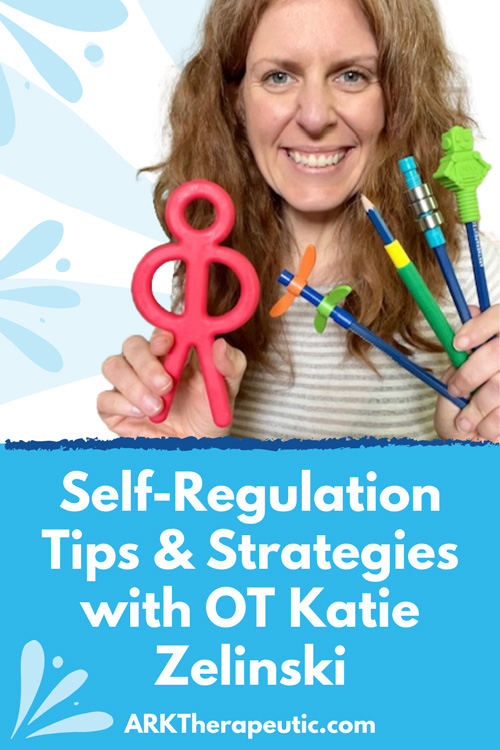
In this webinar, Occupational Therapist Katie Zelinski, MS, OTR/L provides a background on self-regulation, co-regulation, and her favorite tips and tools for keeping the sensory system in a "just right" state.
Hannah: Hi everyone! My name is Hannah and we are going to be learning about sensory strategies to help calm and self-regulate from Occupational Therapist Katie Zelinski. Katie currently lives in Cleveland, Ohio and she graduated from New York University with a Master's in Occupational Therapy. She spent her career starting in early intervention and then transitioning into pediatric clinics, and more recently opening her own business, The Well Balanced OT. She's currently providing mentorships to other occupational therapists to help them feel supported and to thrive in their career.
Katie actually helped kick off our very first webinar ( Z-Vibe Tips & Tricks) in March so we’re really excited to have her back here today with us! And I am just going to let Katie go ahead and start her presentation for today.
Katie: Today we’re going to talk all about regulation and some of my favorite ARK tools to use. Before we do that, I do want to do a little dive into, “What is regulation?” and figuring out the strategies that we can use to best help our children, or ourselves, based on what their needs are.
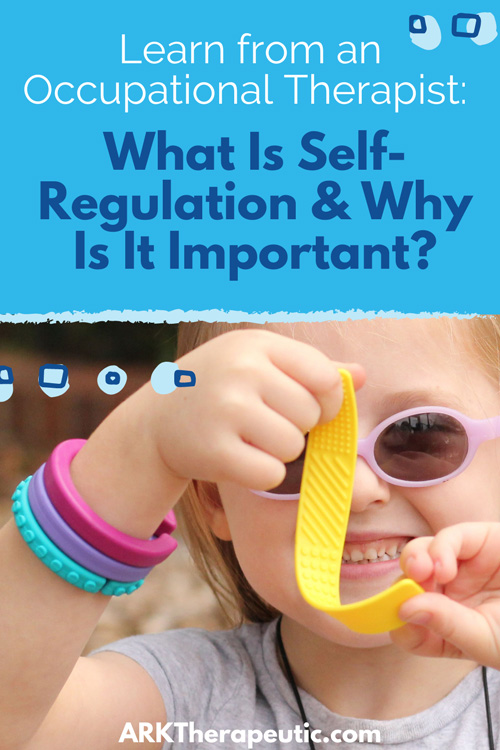
What Is Regulation? [1:30]
Self-regulation is our ability to meet the demands of the world we are in by changing our level of arousal; to return to a just-right state. So, let’s break this down a little bit and we’re going to start with arousal - because I feel that word can be a little bit confusing.
We all flow in and out of different states of arousal. There is a low arousal state, a “just-right” state, and a high arousal state.
Low arousal is often when we’re just waking up in the morning - we’re tired, maybe a little cranky - it’s not the best time to sign important papers or have important conversations. Our brain just isn’t able to focus and function. Maybe we get up, get dressed, have breakfast, maybe work out, take a cold shower - our bodies are slowly using those strategies to help it go into the “just-right” state, where we have our best performance - where we’re able to function optimally.
When we’re in the “just-right” state, our brains are ready to learn, our bodies are engaged and ready to go.
So, let’s think about when we might encounter something that’s frustrating. Maybe we are running late to work, or have a big presentation later in the day so our body is feeling a little nervous. All of those feelings lead to us going into a high arousal state. When we’re in a high arousal state we also might feel scared, nervous, frustrated. Fight or flight - when we feel like we need to run from danger, is also in the “high arousal” state.
For most of us, we’re able to flow in and out of these states of arousal to meet the needs of our environment.
So if we need to go to sleep, we start to go into the low arousal state. If we need to run from danger, we go into the high arousal state. If we are taking a big test ideally, we’re in the just-right state.
A lot of people have trouble flowing between these states. They get stuck, and most often get stuck in that low arousal state or high arousal state.
Why Is Regulation Important? [4:03]
Being in a regulated state, in the just-right state, is important for learning, communication, and attention.
I don’t know if you’ve ever tried to engage a child or person who was dysregulated in a task, they just can’t do it because their brain is either trying to wake up or trying to run from danger. Their brain is not focused on what you’re presenting them. It’s just focused on, “How can I make my body feel better?”
Regulation is important for impulse control - if we are dysregulated, we do not have a lot of impulse control.
And social-emotional development happens when we’re able to get into that just-right state.
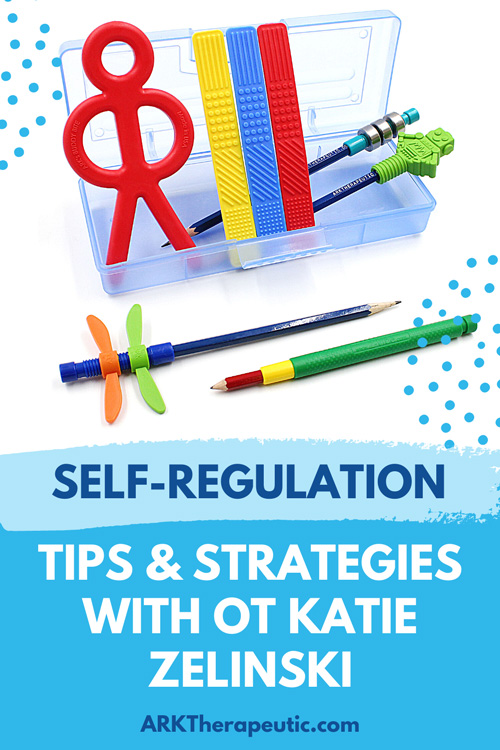
Why Do Some Children Become Dysregulated? [4:50]
So why does it happen; why do children become dysregulated? This can also apply to adults, a lot of what I say will be focused on children because that's the population that I work with most often, but this definitely apply to adults as well!
Having a poor body-brain connection - what does that mean? In the occupational therapy world, we might say that you don’t feel grounded, or connected to your body. Your brain and body aren’t communicating well, and this often happens with kids who might have sensory processing challenges, might have appear clumsy or uncoordinated - these kids really use the adults in their lives to help them feel more grounded, to co-regulate.
Encountering the unexpected is a huge reason why so many kids are dysregulated. Children have a hard time transitioning into new routines or tolerating change.
I was watching a video the other day and a mom told her child that she was going to make carrots for dinner. The child was probably thinking, “I love round carrots! We’re going to have brown carrots for dinner tonight or coin carrots” so they’re cut into little circles. Well the mom finishes cooking the carrots and places them on the table and they’re matchsticks. And the child completely dysregulates and has a meltdown. Well that child just spent the last 30 minutes expecting to see these round, coin carrots on their plate - and they don't, they get long sticks.
They don't necessarily have that flexibility to be like, “Oh they’re different, okay!” - they get stuck in the dysregulated state, because they were expecting one thing but got another.
For these kids doing a lot of preparation talking about change is going to be really, really helpful. I often suggest that a day before something big is going to happen or there’s going to be a change in routine - to discuss it and talk about what their day looks like to prepare them. So that mom who was making carrots, ideally she could have said, "We’re making matchstick carrots tonight," but giving them explicit information to help their body prepare for it.
Sensory Over-Stimulation [7:28]
We all have "sensory cups" and every time we engage with our world and are constantly providing sensory information for us to process, we are filling up our cups with little drops. So when you’re eating maybe a crunchy breakfast, or there's construction outside the house so there's lots of noises - drip by drip you’re filling your cup.
For many of us, we know what strategies to use to help us pour a little bit out of our cup to help our bodies and brain feel more regulated.
For individuals who have trouble with sensory processing - their cup fills and fills, and they don’t know how to dump some of that out to regulate or use those strategies. As their cup gets more full, it overflows and they have a meltdown.
Things like being tired or frustrated or hungry or anxious or in pain - are all things that can lead to dysregulation.
Excitement - I find that this one is sometimes a little surprising because you think, oh they’re excited and happy - they’re not dysregulated. A lot of excitement when you're in that high arousal state can lead to dysregulation. For example, when you think about November and December and being excited for the holidays, seeing family, and presents - those are the times where typically kids have the hardest time maintaining that “just-right” state because they’re so excited about what's to come. So just something to keep in mind when you’re thinking about if or why someone is dysregulated - know that excitement can definitely be a cause.
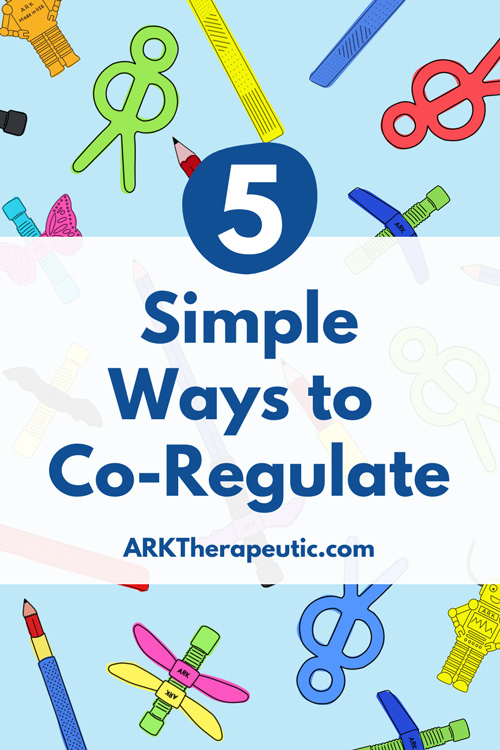
What Is Co-Regulation? [9:32]
Co-regulation is when another person helps an individual regulate through the use of self, modeling, positive attachment, and support tools. I think that we often expect our kids to regulate much earlier than expected.
Co-regulation leads to the ability to regulate our feelings and teaches how to process feelings and how to feel better.
Co-regulation isn't just for kids. I know that if I'm having a bad day and I come home, I want to hug my husband. Or if you’re that person who has a pet and snuggles with that pet. We use other people all the time - calling a parent to help process our feelings. All of those are forms of co-regulation and they help us to feel better and process our feelings.
But when we’re talking about children, co-regulation helps kids to learn how to self-regulate as they get older.
5 Simple Ways to Co-Regulate [10:49]
1. Deep pressure hugs: One of the best free tools that you have, is really yourself - giving a hug, providing deep pressure can help co-regulate.
2. Being present: Putting phones away, taking 10 minutes out of your day to spend with another person and focus on them. If we're talking about kids, let’s engage in a child-led activity where they are leading how we play and in control. Maybe we’re narrating, but we’re focusing on that child. Being present and sitting with the child is going to help them regulate through any emotion that they’re feeling.
3. Modeling deep breathing: I know that as an adult, if someone tells me to take a deep breath, I’m like, “don't tell me what to do!'' And kids feel the same way. So instead of telling them what to do (and remember - if they’re in that high arousal state their brain isn't paying attention anyway), I’ll take a deep breath and model it for them. I keep going and ideally they start to imitate. We’re providing that model to them. If the child is really young, I'll place them on my lap and they can feel my breath and that will ideally help them to regulate their breath as well.
4. Using your tone of voice to calm or to increase arousal: If somebody is in that low arousal state, I will use animated gestures and I’ll play around with the tone of my voice. So I might increase it a little bit - like a singing voice when playing. But if that person needs to calm and regulate (to down-regulate), then we’re going to talk in a more clam, slow tone of voice and cadence.
5. Then we want to encourage regulating activities: specifically, with activities that are right for the child (because there is a difference).
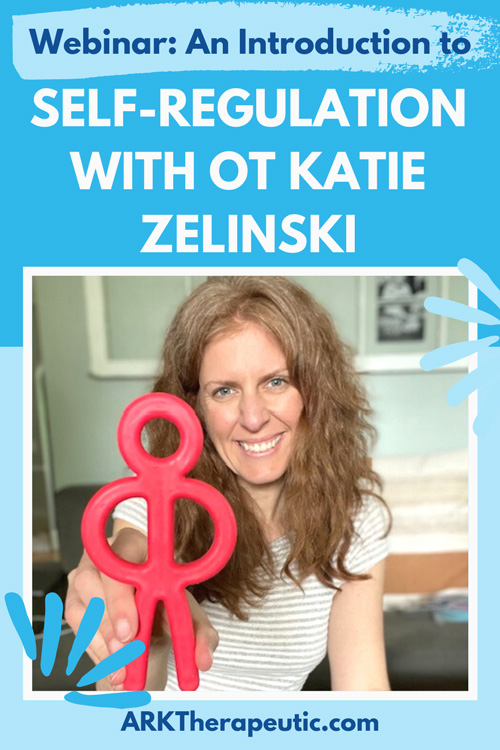
Characteristics of Different States of Arousal [12:55]
We're going to talk about the different characteristics of arousal - whether you're in a low or a higher arousal state.
We know that being in a low arousal means we’re likely going to be sluggish, and might be lacking behind, have limited attention.
If we’re in a high arousal state, you might notice some anxiety, and more avoidant behaviors (running away as a big one). Hiccups - that’s actually a stress sign in babies and that continues as they get older as well.
And most people are familiar with the later stages of dysregulation - that aggression, crying, and meltdown. When someone gets into these last 3 stages, co-regulation is the best way to support them. Using tools and strategies at this point isn’t going to help, they just need to get through the meltdown and being there and being supportive of that person is really the only way to help.
When we see these other characteristics (limited eye contact, hiding, sweating, flushed skin, etc.), then we want to provide those strategies when we see those earlier signs of dysregulation.
I know that sometimes we think the child goes from 0 to 100 - even some adults go without any warning - there is always some warning that it’s going to happen. We just have to pay attention to what those cues are and learn what they mean when they're starting to dysregulate.
I think that it’s really important to note that these behaviors are not an attempt to manipulate or an attempt to control the environment. They are an attempt to ask for help. They are the body's way of saying: I need you to help me and my body.
For individuals who are in that low arousal state, alerting activities are really beneficial. Movement is a very alerting activity. So if we go into inversion (upside down). If we do lots of rotary and spinning - fast paced movements. Vibration can also be very alerting. It can also be used for calming those higher arousal kids.
When you’re thinking about higher arousal, think about resistive deep pressure - so those big hugs and stimulating the proprioceptive system through pushing and pulling [ heavy work]. All of those things will help with a child who is in that high arousal state to a more just-right state.
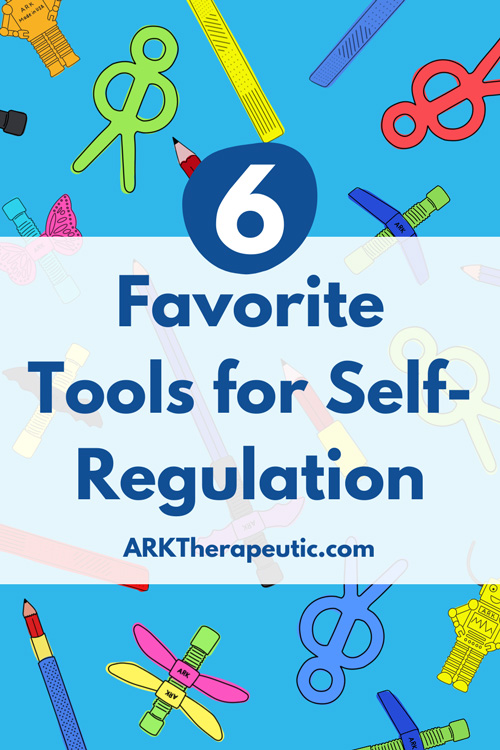
Favorite Tools for Self-Regulation [15:50]
Now we’re going to talk about some of my favorite tools, but first I want to share some of my rules when picking tools.
- I always want to emphasize that these are tools - not toys. I think self-regulation tools often get a bad reputation because people use them as toys or refer to them as toys and often they're marketed as toys. When they’re tools that help individuals focus better, that help brains work better. And if we call them toys, typically I know schools will go with the fidget spinners, they're banned in a lot of schools because they were being used by children who did not need them, so they weren’t using them effectively. The child or adult whoever is using them, should be explicitly taught how to use the tool. I never want to be like, “here, use this” without showing them how to use them. If they don't have the knowledge, then the tool isn’t going to be effective.
- Each tool should also be paired with the child based on their needs, arousal level, and sensory profile. We don’t want to have a box of tools and just show it to the child and say pick one.
- Lastly, ideally - the tool does not roll away, it’s small, and bonus - if it is also functional.
So a lot of tools that I'm showing today, to make it a little easier - can be beneficial for both low and high arousal presentations. As I go through each one I’ll explain it a little bit more.
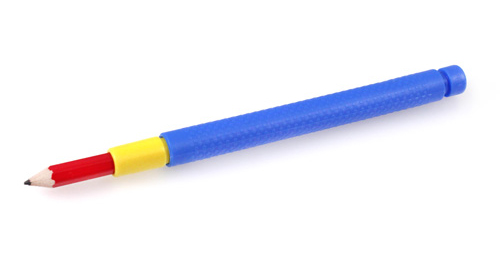
1. Using the Z-Vibe [17:50]
The first one that we’re going to talk about is the Z-Vibe with the pencil attachment. This is also available as part of the Tran-Quill Writing Kit, or you can buy the pencil attachment independently.
I absolutely love using vibration in my sessions and if you haven't watched it yet, check out the very first webinar that we did. We talked about the Z-Vibe and the benefits of vibration. You can watch the webinar here.
Vibration can be both alerting and calming depending on the child.
So when you’re using vibration, it’s important to try it out and see how the child responds and see if the vibration is helping turn their body on or if it's causing dysregulation.
I chose this one because the writing attachment, the pencil attachment - makes it super functional. They also have a pen attachment and crayon attachment. You can use this Z-Vibe, turn it on to provide vibration, and use it every single time when writing. It provides a lot of vibration throughout your day to help you regulate. Prior to the Z-Vibe I was using a clunky massager which is not super functional throughout your day, but this makes it functional and helps bring that child to that just-right state.
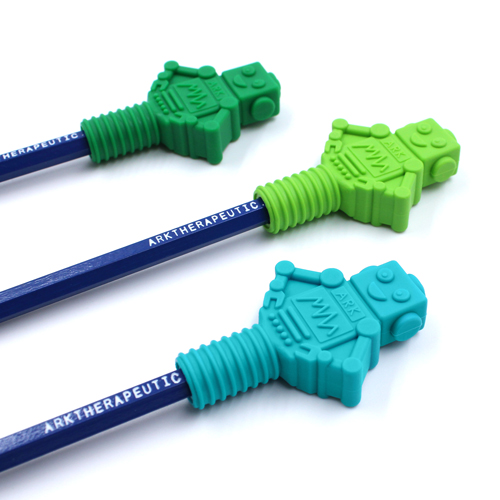
2. Using the RoboChew Pencil Topper [19:50]
Next up we’re going to talk about chewing and I have the Robot Pencil Topper to show you.
Chewing can be helpful for both low and high presentations, but there is a difference.
If somebody is in that low arousal state, they’re tired and sluggish - we want things that are crunchy. So I want you to take a second right now, we’ve probably been sitting here for just about 10 to 15 minutes and I want you to think about what strategies you’re using to alert your body.
- Are you chewing on something?
- Are you tapping your foot?
- Are you drawing on paper?
- Are you doing any of those things to help your body stay focused?
All of these things are tools just like all the ones that I’m showing you - tools to help your body attend. And chewing is one of those tools. So low arousal state - you want crunchy things like pretzels or carrots or celery.
When you’re in a high arousal state, you want things that are more resistive. Chewing provides that proprioceptive input to the jaw that allows the child or adult to chew on and get that deep, deep input.
The Robot Topper comes in different strengths (toughness levels). So this green one is extra tough (medium XT level), you can see that I can bend it. I really like this one for self-regulation because not only are you getting the receptive benefits of chewing, you’re able to take it off your pencil and hold it in your hand to use as a fidget.
This orange one is XXT (extra extra tough) – you’ll see that it’s much harder to bend. So if you’re someone who likes chewing but also fidgeting, I’d recommend going with the extra tough (XT /medium) one. If you’re someone who really needs to chew, maybe destroying shirts or chewing hair, erasers, pencils - go with the extra extra tough (XXT / toughest) one because it’s harder to destroy and will provide a lot more input to the jaw.
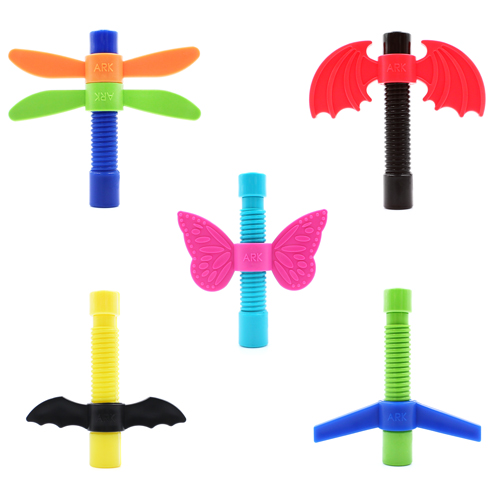
3. Using the Wingamajigs Fidgets [22:44]
Next up we have the Wingamajigs - these are the Dragonfly Wingamajigs but there are different designs that you can get [dragonfly, dragon, bat, airplane, or butterfly]. What I love about these fidgets is that they allow the body to move just a little bit. Just like I was asking if you’re clicking your pen or tapping your foot, these allow the body to fidget in a way to help your brain focus better.
The Wingamajigs are great because they can either go on top of a pencil or can be held in your hand. So it’s small and just like the robot topper, it doesn’t roll away when it drops - so it meets my rules.
You can tap it [the Dragonfly has two wings that can spin separately by tapping with your fingers] so it goes down - giving you a little bit of visual stimulation if you are trying to alert or wake up your body, stimulating the tactile system, or your visual system.
If you are using it to help your body calm down, it also provides some proprioceptive input. If you get the two wings close together and you just give it a little push and resistance in your fingertips, and then you release and you push again. You can take the pencil off so it’s just in your hands, and you’re getting some of that proprioceptive input which is very calming.
I love that if you're a student, it can go under the desk and in your hands or be very discreet on top of your desk.
Another awesome thing about the Wingamajigs, I didn’t talk about breath work at all - but deep breathing and breath work is very, very regulating. So with this you can use your breath instead of your finger to spin the wings.
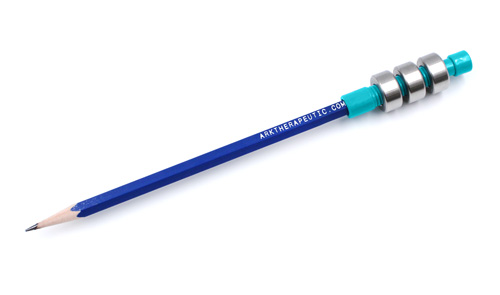
4. Using the Weighted Pencil [25:06]:
Next up we have the Weighted Pencil - weighted pencils are often used for people who need more appropriate receptive input.
So if you think about those individuals who really like to push and pull things, or hang from things, to get that heavy work into their body and concentrate better. Well we can’t necessarily do those things in my head, or when we’re at work or school. The weighted pencil is a tool that allows you to get some of that proprioceptive input while you are working. And if you are using it with a younger child, I do recommend using one of those shorter golf pencils so it’s not as long.
Another thing - all of these toppers come off the pencil, so again, it can turn into a quiet fidget that you can use discreetly. The weights can rotate around so you can push, pull, and spin them. Also when it drops, typically it doesn’t roll away and it’s small to fit in the palm of my hand - it meets all of my criteria!
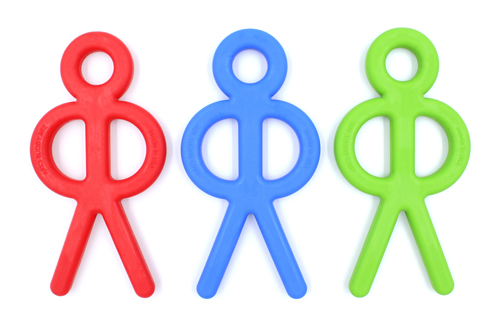
5. Using the Buddy Bite [26:33]:
Next up we have the Buddy Bite - from the name, it’s obviously used for chewing but I also use it slightly differently. These legs are great for chewing and reaching the back molars to give you that proprioceptive input, but I really like to use it as a hand tool, or hand fidget. The legs are great for squeezing together.
The Buddy Bite comes in 3 different strengths, you can see me squeezing this one [the Buddy Bite in XXT toughest level] - it takes a lot more effort. I can’t even get it all the way down! So for those kids who really need that deep pressure, this is great. If you’ve ever been in hand therapy or if you’re a therapist, it reminds me of a hand strengthening tool you would use to squeeze together. It’s giving you some of that deep pressure without having to have a lot of movement with your body.
Another reason why I love this is that your fingers can go in the different holes and twist it around. So if you’re a person that likes twisted jewelry or twists at your clothing, this is a great one to use without having to destroy clothing or break a necklace.
I also use these all the time as tongs. If you’re looking for more ways to incorporate deep pressure with your kids or clients, we use them to pick up items and do transfer tests picking up food. It’s a really fun way instead of using chopsticks when using these legs and kids will have a blast doing it.
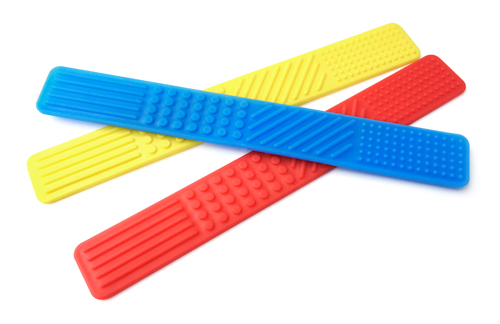
6. Using Sensory Bookmarks [28:30]:
Lastly we have these Sensory Bookmarks. They come in sets of three and if you were able to see it here - you’ll see there's four different textures on the bookmarks. The lines depending how your finger is stroking it, the lines are a bit smoother and the bumps are providing more texture and input. I love that these bookmarks are functional, you can keep it in your books, pencil case, or in your pocket. And I love that they’re providing that tactile input that's a little bit of movement that you can get with your hand for the fidgeting aspect and it’s super transportable.
If you’re a teacher or occupational therapist, you’ve probably recommended or used velcro for kids that like to fidget with things and put velcro on the desk. Instead of sticking velcro to the desk and having to take it off every year, I think this bookmark is a great replacement. These small little bumps feel like velcro to me, they’re a bit rougher, and it’s giving you the same input but now the child can take this bookmark with them or anywhere they go if they need that bit of input throughout their day. It is super flexible which makes it easy to put it in your pocket or as a hand fidget. So it meets multiple, multiple needs!
So those were all of my favorite tools! Now we’re going to pass it back to Hannah to see what questions are out there.
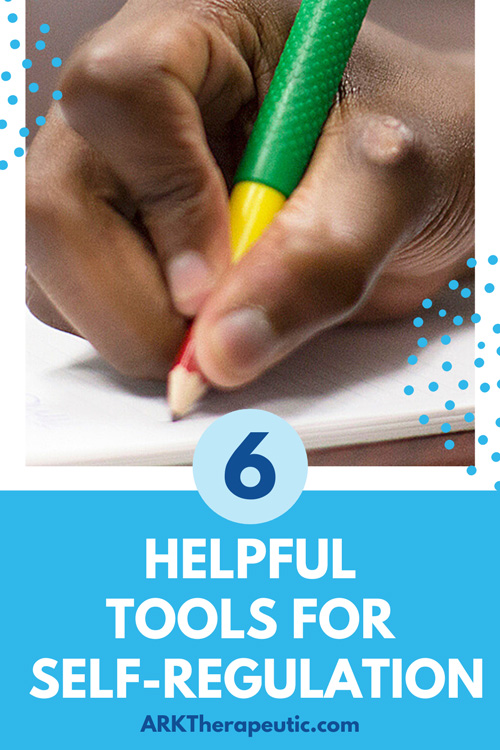
QUESTION TIME [30:32]
Hannah: Thank you Katie, that was wonderful! Yes, we do have some couple questions that came through. First question: What is the difference between a meltdown and a tantrum?
Katie: Okay, so a meltdown typically happens because of sensory overstimulation - their sensory cup is full, overflows, and the child becomes so dysregulated that they melt down. With a meltdown, it does not go away. So you may think to yourself, "I’m going to give them this thing and they’re going to stop crying" - it doesn’t happen like that. It can take a child 15 minutes, 20 minutes, sometimes an hour to recover from a meltdown because their sensory system is so overloaded.
When there is tantrum, it typically happens because we have said no or we have taken something away. And if you give that thing back to the child, their crying stops immediately and that response is a really easy way to identify whether something is a tantrum or a meltdown. Both are forms of communication and both are trying to tell you something. Whether it’s, “My body needs help regulating,” or, “Something’s going on, I need more support,” during a tantrum.
I will say, the best way to avoid tantrums is to stick with your word; stick with what you say. If we say, “No, we can’t have this,” or, “No, not today,” stick with it because if they cry and you give in, they know that next time, “I’m just gonna cry a little bit longer, and that person will probably give in.”
So, stick with you word, but also try and use the opportunity to connect with that child—that’s kind of what they really want anyway.
Hannah: This is a question about teachers: If teachers are not on board with tools in the classroom, if they think they will be distracting for other kids for example, what can we say to help them understand?
Katie: I explain that these tools are necessary for their brain to function. Instead of coming from the point of view of, “It’s going to distract the class,” let’s come from the point of view of, “Let’s educate the class.”
If this is a therapist asking, I might offer to come in and give a little presentation to the kids and talk about all the different tools we use to help our brains focus. I think it’s really hard if we say, “Hey, other classmates are going to be really distracted if one kid uses this tool,” but also, the kid [who needs the tool] is going to be really distracted without the tool. There has to be a happy medium.
I sometimes will say, "Let’s try it and see what happens." If we try it and we’re effective, the teacher can see a difference in the person using it. But sometimes it takes a little bit of effort to get the teacher on board.
I will also say, I think that making it easier for the teacher to implement [the tool] is going to make them more receptive and more willing to use it. Even if we are taking away some of the tools but using activities in the classroom they can do that are embedded in their day naturally. For example, depending on the age of the student, if there are “classroom jobs” - having those kids who need that movement and heavy work to water plants, or be the door opener, or be the librarian and bring books to the library. Having the teacher see some of the changes for the better may help them be more accepting of implementing tools.
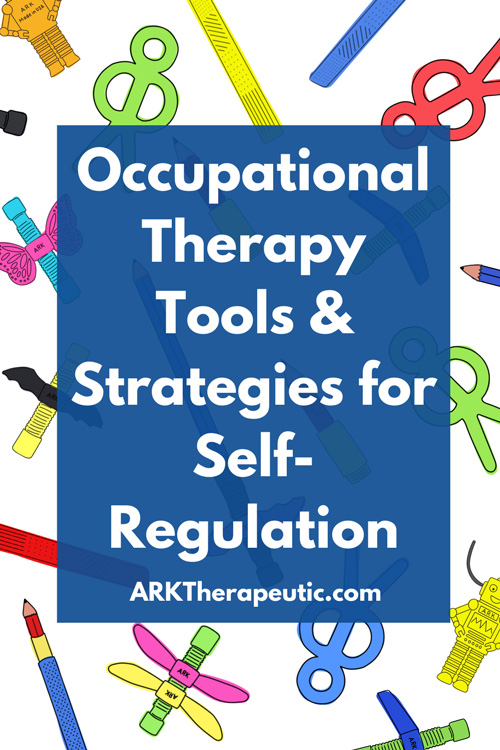
Hannah: Someone’s asking: “These tools are awesome, but my son gets aggressive when he’s in high [arousal] mode. What calming techniques can one use without objects when they are in the heat of the moment and won’t easily accept a device of object?”
Katie: When they are in that aggressive state, never offer something. Their brain isn’t in the state to be able to accept it and use it effectively. They’re just in protective mode. That’s where that co-regulation comes into play. If that child is being aggressive, we want to make sure that they have a safe space. Whether that be a tent, or their room, or a sensory space. We want to make it as friendly for that child as we can.
If they are in a state of overstimulation, we want to decrease what’s overstimulating for them. If they respond negatively to noises, we want to make sure it’s quiet. If they’re over-responding to visuals, we want to go in that tent and limit how much that child sees. We want to make sure they know that we are there to support them; maybe you’re sitting inside the tent with them, or sitting outside the tent if they don’t want you right next to them—maybe you’re not saying anything at all, but you’re just in their sight. You are using yourself in that moment to help them regulate. In those scenarios, it's likely there's a characteristic, or behavior that you see ahead of time, or haven’t seen yet—but there likely is something you can identify before the aggression happens that will help you say, “Okay, now is the time to use a tool.” Once it gets to aggression, it’s just a little too late.
Hannah: Another question: Do you know if chew tools cause problems with TMJ?
Katie: I don’t think so! I don’t know for sure—I’ve never had a child, adult, or anyone respond that that has happened. These kids who are seeking chewing are going to do it whether they’re using a chew tool or something else. We want to make it as safe as possible for them, and I think using a chew tool versus not giving them a tool and allowing them to chew on other things [not meant for chewing] is probably more dangerous than the possibility of TMJ happening.
Hannah: Another question we have: Do you think chew necklaces or pencil toppers are better for the classroom, in terms of cleanliness?
Katie: I think it depends on the child’s needs—some do not want to wear chew necklaces, other kids will love them. I think a necklace is great because it’s with them at all times, it’s not going to drop on the floor, so if cleanliness is something you’re thinking about, ideally the necklace stays on them. But they sometimes will come off depending on the child and what their mood is.
The pencil topper is nice because every time they’re picking it up, they’re seeing it—but it is going back on their desk, so there is that piece to it. If the child’s a little bit younger, I might go with just the necklace and as they get older you can talk about cleanliness factors using this [the pencil topper]. Maybe they put it in a special spot after they’re done chewing on it, or they know how to wash it off, if needed. I think it’s all about educating the child, but the age will affect that.
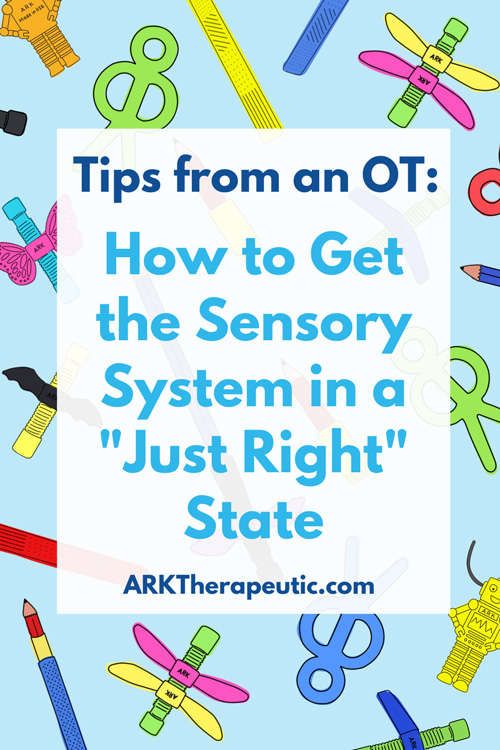
Hannah: Well, we still have some time! Another question: Does giving someone a chewy encourage them to chew on other things? So, if you give someone a chewable pencil topper, does that teach them to chew on pencils?
Katie: It might depend on the child. I think most of the time, we are giving them the tools because they need it. They are indicating ahead of time that they’re already chewing on something. If the child isn’t a chewer, I wouldn’t necessarily give them that pencil topper. I would give them something else that would help them regulate. This is where understanding the sensory profile for that child is helpful in picking your tools. If they’re a chewer, they’re naturally going to chew on things anyway—if they’re not a chewer, we’re going for something different.
Hannah: A few people have asked about tooth grinding—Aside from chewies, do you have any suggestions to help with tooth grinding?
Katie: The Z-Vibe! I will turn it on and use one of the tips, or the back end, and apply the vibration to the TMJ joint—it will help them decrease that chewing. They might pull away, I don’t force anything, but I might come back to it, or allow them to bring it to their face. Using the Z-Vibe for different points on your body can be very regulating. You can use it on the TMJ joint, on your chin, your lip, even your forehead are all really regulating spots, and providing that vibration will definitely help. But the Z-Vibe and massage to the TMJ is really helpful for toothgrinding. I’ll come in with both [index] fingers and massage [the TMJ joint on both sides]—again, sometimes they’ll resist, don’t force anything—but both of those things will help decrease grinding.
Hannah: Great! Thank you everyone for the questions! I hope that helps. We are running out of time here.
Katie: Thank you so much for having me! I have a regulation guide that goes much more in depth [linked below], and has a lot more strategies and activities you can use. It definitely includes some of the ARK tools in there as well—so you guys will have access to that as well!
Hannah: Wonderful! Thank you guys for attending, we hope you learned something new today. Thank you, Katie, again, for hosting another webinar with us, we will see everyone next time!
Katie: Thanks guys, bye!
An OT's Guide to Regulation in the School (for teachers and occupational therapists for use in school)
An OT's Guide to Regulation for Parents - How to Promote Self-Regulation at Home (for parents/caregivers to support at home and in the community)
Katie Zelinski graduated from New York University with a Masters in Occupational Therapy. She currently lives in Cleveland, Ohio. She has additional training in Ayres Sensory Integration, S.O.S., feeding, reflex integration, and iLs programs.
Follow Katie on Instagram @the.well.balanced.OT or visit her website at www.TheWellBalancedOT.com.
.

